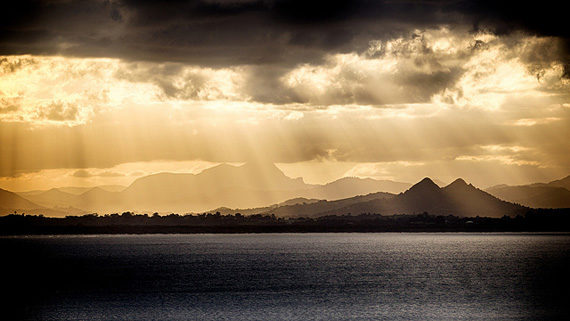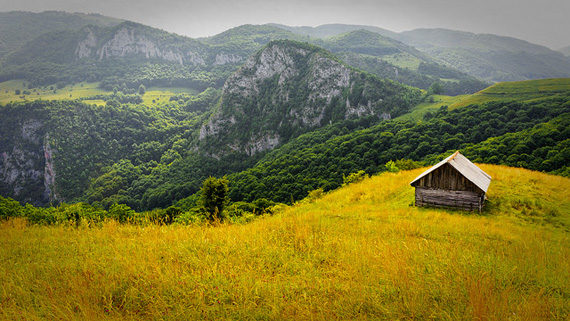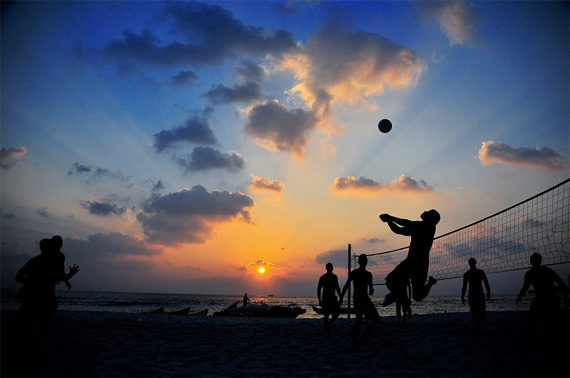Related reminder: deal ending soon on The Fundamental Photo Lighting Guide at 70% Off
Along with composition, the quality of light is perhaps the most important factor affecting the success of a landscape photograph. Whilst composition can be completely controlled, good quality light on the other hand cannot. We can however control the direction of the light and therefore use the optimum angle of light to enhance the appearance of our main subject and ultimately the success of our landscape photograph. There are four main types of lighting: top, side, front, and back lighting. Consider how your envisaged scene will appear under each type of lighting and then choose which type of lighting will best portray your subject and shoot at the specific time and in the specific position to capture your subject in this light.

Photo by Richard Rydge; ISO 250, f/8, 121 mm.
Occurring during the middle hours of the day:
Top Lighting
Generally speaking for landscape photography, top lighting is to be avoided as it does not cast any shadows and therefore does not convey texture, form and shape which are so important to emulate dimension in a landscape photograph. The only exception to using top lighting is when you wish to capture water at its most turquoise color, which occurs when the sun is positioned directly above.
Occurring leading up to sunset and a short time after sunrise:
Front Lighting
Similar to top lighting front light also does not produce texture, form, and shape and even worse, your shadow will more than likely appear in the scene. Try and avoid this lighting in any situation.

Photo by Hefin Owen; ISO 100, f/7, 1/320 exposure.
Back-lighting
Back lighting is difficult to shoot in not only because of the extreme brightness between the subject and background but also because lens flare becomes an issue. If you do choose to shoot in back-lighting conditions then it’s recommended to use a lens hood to shade the top of the lens in order to prevent flare. The only exception to using back lighting in landscape photography is when you wish to create a silhouette of your subject which is only possible using back lighting.
Side lighting
Side lighting is the ideal light source to reveal a subject’s texture, form, and shape as it casts beautiful subtle shadows to provide a sense of dimension of the subject and therefore creating a more ‘life-like’ image that the viewer can better relate to. As creating a three dimensional image is often one of the main goals of the landscape photographer, strive to capture your subject using side lighting.
To control the direction of light simply change where you stand!
Finally an interesting note is that shooting during the different times of year can actually produce different results under the same lighting conditions and angle. For example the color of water is different depending not only on the angle of the sun but also the time of year. For example, trying to achieve turquoise water is best achieved right in the middle of the day as the top light penetrates straight through the water. However the same image taken at the same time in winter compared with summer will result in the water not becoming as turquoise because the sun does not completely travel overhead during the shorter winter days and instead only rises up as far as ¾ during the middle of the day.
About the Author:
Ricardo Manuel Da Cunha writes for http://www.ricardodacunha.com.au/ and specializes in running landscape photography courses and providing private photography tuition.
For Further Training on Light, Deal Ending Soon:
As a photographer understanding light is absolutely critical. It doesn’t matter whether you’re a beginner or a professional – light is the most important element in photography. This popular 125 page in-depth tutorial eBook educates photographers on the most critical and important aspects of harnessing light in photos. We were able to arrange an exclusive 70% discount which ends soon.
This guide aims to help you understand the essentials of light so you can look at a scene, describe the light, and actually understand why it looks the way it does. And then you’ll know the options you have for controlling and changing that light to suit your tastes.
Deal found here: The Photographer’s Guide to Understanding Light at 70% Off
Go to full article: Using Natural Light in Landscape Photography
What are your thoughts on this article? Join the discussion on Facebook
PictureCorrect subscribers can also learn more today with our #1 bestseller: The Photography Tutorial eBook
The post Using Natural Light in Landscape Photography appeared first on PictureCorrect.

